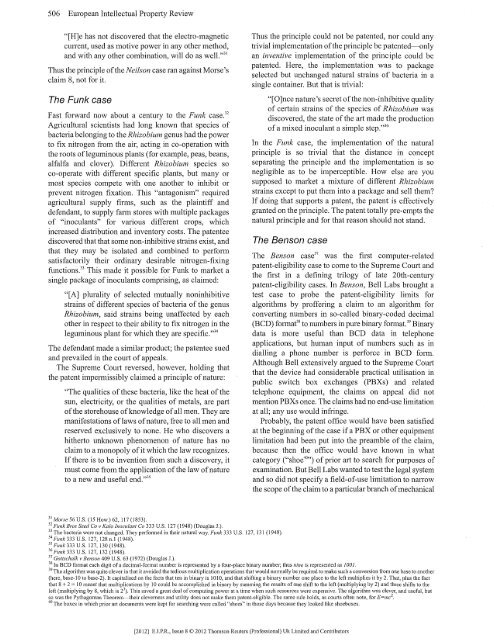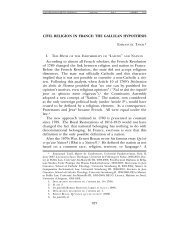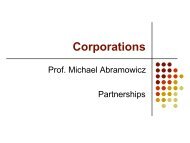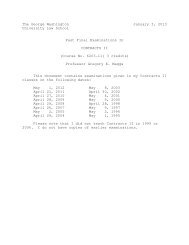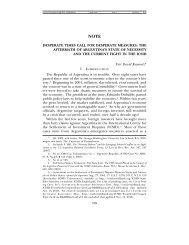Mayo v Prometheus - Gwu - George Washington University
Mayo v Prometheus - Gwu - George Washington University
Mayo v Prometheus - Gwu - George Washington University
Create successful ePaper yourself
Turn your PDF publications into a flip-book with our unique Google optimized e-Paper software.
506 European Intellectual Property Review<br />
"[H]e has not discovered that the electro-magnetic<br />
current, used as motive power in any other method,<br />
and with any other combination, will do as well." 31<br />
Thus the principle of the Neilson case ran against Morse's<br />
claim 8, not for it.<br />
The Funk case<br />
Fast forward now about a century to the Funk case. 32<br />
Agricultural scientists had long known that species of<br />
bacteria belonging to the Rhizobium genus had the power<br />
to fix nitrogen from the air, acting in co-operation with<br />
the roots ofleguminous plants (for example, peas, beans,<br />
alfalfa and clover). Different Rhizobium species so<br />
co-operate with different specific plants, but many or<br />
most species compete with one another to inhibit or<br />
prevent nitrogen fixation. This "antagonism" required<br />
agricultural supply firms, such as the plaintiff and<br />
defendant, to supply farm stores with multiple packages<br />
of "inoculants" for various different crops, which<br />
increased distribution and inventory costs. The patentee<br />
discovered that that some non-inhibitive strains exist, and<br />
that they may be isolated and combined to perform<br />
satisfactorily their ordinary desirable nitrogen-fixing<br />
functions. 33 This made it possible for Funk to market a<br />
single package of inoculants comprising, as claimed:<br />
"[A] plurality of selected mutually noninhibitive<br />
strains of different species of bacteria of the genus<br />
Rhizobium, said strains being unaffected by each<br />
other in respect to their ability to fix nitrogen in the<br />
leguminous plant for which they are specific." 34<br />
The defendant made a similar product; the patentee sued<br />
and prevailed in the court of appeals.<br />
The Supreme Comi reversed, however, holding that<br />
the patent impermissibly claimed a principle of nature:<br />
"The qualities of these bacteria, like the heat of the<br />
sun, electricity, or the qualities of metals, are part<br />
of the storehouse of knowledge of all men. They are<br />
manifestations oflaws of nature, free to all men and<br />
reserved exclusively to none. He who discovers a<br />
hithetio unknown phenomenon of nature has no<br />
claim to a monopoly of it which the law recognizes.<br />
If there is to be invention from such a discovery, it<br />
must come from the application of the law of nature<br />
to a new and useful end." 35<br />
31<br />
Morse 56 U.S. (15 How.) 62, 117 (1853).<br />
32<br />
Funk Bros Seed Co v Kala Inoculant Co 333 U.S. 127 (1948) (Douglas J.).<br />
33<br />
The bacteria were not changed. They performed in their natural way. Funk 333 U.S. 127, 131 (1948).<br />
Thus the principle could not be patented, nor could any<br />
trivial implementation of the principle be patented-only<br />
an inventive implementation of the principle could be<br />
patented. Here, the implementation was to package<br />
selected but unchanged natural strains of bacteria in a<br />
single container. But that is trivial:<br />
"[O]nce nature's secret of the non-inhibitive quality<br />
of certain strains of the species of Rhizobium was<br />
discovered, the state of the art made the production<br />
of a mixed inoculant a simple step." 36<br />
In the Funk case, the implementation of the natural<br />
principle is so trivial that the distance in concept<br />
separating the principle and the implementation is so<br />
negligible as to be imperceptible. How else are you<br />
supposed to market a mixture of different Rhizobium<br />
strains except to put them into a package and sell them?<br />
If doing that supports a patent, the patent is effectively<br />
granted on the principle. The patent totally pre-empts the<br />
natural principle and for that reason should not stand.<br />
The Benson case<br />
The Benson case 37 was the first computer-related<br />
patent-eligibility case to come to the Supreme Court and<br />
the first in a defining trilogy of late 20th-century<br />
patent-eligibility cases. In Benson, Bell Labs brought a<br />
test case to probe the patent-eligibility limits for<br />
algorithms by proffering a claim to an algorithm for<br />
converting numbers in so-called binary-coded decimal<br />
(BCD) fmmaes to numbers in pure binmy formae 9 Binary<br />
data is more useful than BCD data in telephone<br />
applications, but human input of numbers such as in<br />
dialling a phone number is perforce in BCD form.<br />
Although Bell extensively argued to the Supreme Court<br />
that the device had considerable practical utilisation in<br />
public switch box exchanges (PBXs) and related<br />
telephone equipment, the claims on appeal did not<br />
mention PBXs once. The claims had no end-use limitation<br />
at all; any use would infringe.<br />
Probably, the patent office would have been satisfied<br />
at the beginning of the case if a PBX or other equipment<br />
limitation had been put into the preamble of the claim,<br />
because then the office would have known in what<br />
category ("shoe 40 ") of prior art to search for purposes of<br />
examination. But Bell Labs wanted to test the legal system<br />
and so did not specify a field-of-use limitation to nanow<br />
the scope of the claim to a particular branch of mechanical<br />
34 Funk 333 U.S. 127, 128 n.l (1948).<br />
35 Funk333 U.S. 127, 130(1948).<br />
36 Funk 333 U.S. 127, 132 (1948).<br />
37 Gottschalk v Benson 409 U.S. 63 (1972) (Douglas J.).<br />
38 ln BCD format each digit of a decimal-format number is represented by a four-place binary number; thus nine is represented as 1001.<br />
39 The algorithm was quite clever in that it avoided the tedious multiplication operations that would normally be required to make such a conversion from one base to another<br />
(here, base-10 to base-2). It capitalised on the facts that ten in binary is 1010, and that shifting a binary number one place to the left multiplies it by 2. That, plus the fact<br />
that 8 + 2 = I 0 meant that multiplications by I 0 could be accomplished in binary by summing the results of one shift to the left (multiplying by 2) and three shifts to the<br />
left (multiplying by 8, which is 2\ This saved a great deal of computing power at a time when such resources were expensive. The algorithm was clever, and useful, but<br />
so was the Pythagorean Theorem-their cleverness and utility does not make them patent-eligible. The same rule holds, as comis often note, for E=mc 2<br />
40 The boxes in which prior art documents were kept for searching were called "shoes" in those days because they looked like shoeboxes.<br />
[2012] E.I.P.R., Issue 8 © 2012 Thomson Reuters (Professional) Uk Limited and Contributors


